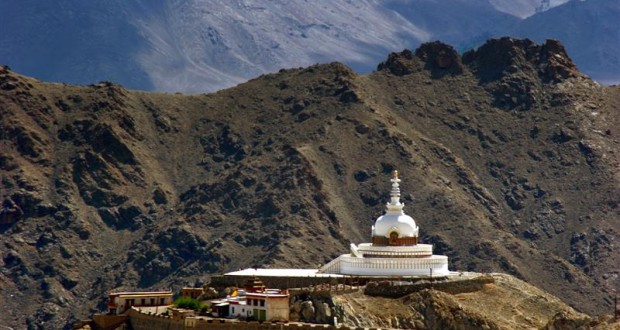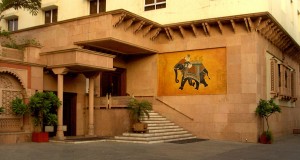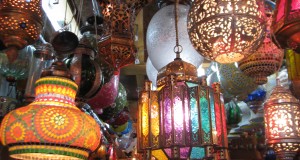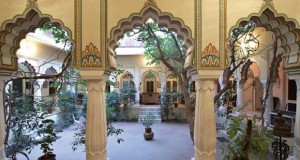Review Overview
3
Summary : Leh, the ancient capital of Ladakh, lies in a fertile side-valley some 10 km north-east of the Indus.
Leh, the ancient capital of Ladakh, lies in a fertile side-valley some 10 km north-east of the Indus. Long ago, it was an important stop on the old caravan ‘silk road’ from China. Today, it’s a quiet little township and tourist centre, overlooked by a hilltop palace and monastery. Travellers like it for its old royal buildings, rustic curio shops, hippie-style restaurants, cheap guest-houses and pioneer-town atmosphere. The markets are crowded with Ladakhis dressed in colourful splendour, and with tourists sneaking up on them with cameras. The popular greeting in these parts is ‘Julie’ (pronounced jew-lay), which means hello, goodbye, and please can I take a photo? The town’s population is fairly evenly divided between Buddhists and Muslims, and the town has as many mosques as it does monasteries. Leh also serves a military base, and the road in from the airport 10 km (6 1/4 miles) out of town, near Spitok Gompa is lined with army installations. Despite road-signs like ‘India, one brilliant bouquet, Ladakh, one bright flower’ and ‘Remember, we are Indians first and foremost’, it’s hard to forget that the army is here to counter the presence of 100 000 Chinese troops parked just across the border.
ARRIVAL/DEPARTURE
Air Leh is connected with daily flights from Delhi (Rs1348) some of which are via Chandigarh (Rs876). Flights from Jammu and Srinagar were stopped in late 1992 due to lack of traffic.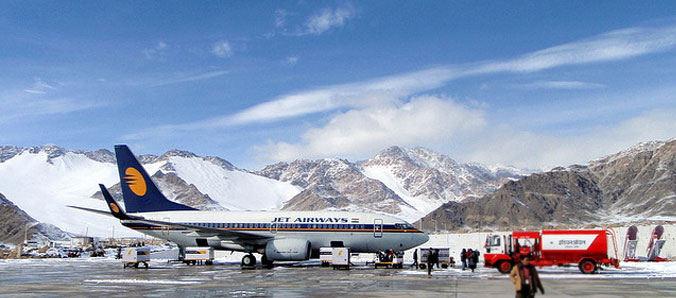
Road There are local buses to Leh from Srinagar from around early June to late October. The journey takes 2 full days with an overnight stop at Kargil. Kargil has poor food, but fair accommodation—a Tourist Bungalow and a Circuit House, plus several small family hotels. To get there in pre-season months, travellers used to either hitch a lift from Sonamarg (army trucks cut through to Leh as early as mid-May), or tag onto a trek heading over the Zoji La Pass from Srinagar. The opportunity for both is presently limited, and such a course is really not advisable. From Kargil buses run throughout the year to Leh. Buses back to Srinagar from Leh often can’t be booked till the evening before departure—ask your hotel manager for assistance. For two short months, from late July to late September, the road from Manali to Leh is open to jeep and bus traffic. The journey is certainly as spectacular as the one from Srinagar but much harder, crossing three major ranges of mountains and touching 5325 m on the Taglang La. Buses leave Manali most days during the short season and jeeps can be hired for the journey. Little food is available en route.
Perhaps the biggest advantage of reaching Leh by road is that the 2- to 3-day journey allows you to acclimatise to the high altitude.
WHAT TO SEE
The altitude in Ladakh has different effects on people. Even the strongest and fittest have been known to suffer from altitude sickness the first symptoms of which can be lethargy, nausea and headaches—often all three. The first day in Leh is best spent relaxing in your hotel. At most, go for a short walk in the evening. Many doctors advise at least two days to acclimatise—this is especially important if you fly into Lei.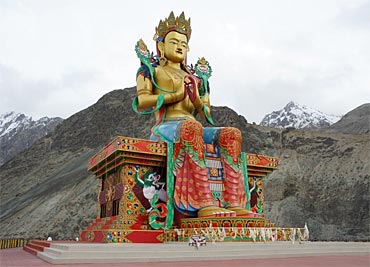
Central Ladakh occupies a large part of the Upper Indus Valley, and its 40 or so gompas are widely spread. Getting out to them is easy because the roads are so good (because the army uses them). Tourists aren’t allowed to wander more than a mile off the main roads, on pain of arrest, and you can only visit about a Cozen of the monasteries. Most of these are locked, and you will have to ask to be shown around. Your escort is usually a friendly if inscrutable monk who sticks to you like a shadow, to stop you wandering off. His attempts to illuminate the beautiful frescoes and murals with candles are often fruitless: mo st of the chambers are gloom-laden, and you’ll need a powerful flashlight to ee anything. All the gompas charge admission; most hold prayers from 5-9 amp, and 4-7 pm; a few (Hemis, Thikse, Alchi, Rizong, Lamayuru) put up travellers overnight. Staying in cold, draughty gompas is spartan (you sleep on the floor, and pray for more blankets), but it’s cheap and there’s certainly no better way of absorbing the mystic, ascetic Ladakhi lifestyle.
A good altrnative is to walk in the valley—strolling from village to village, staying up in family houses or in the occasional travellers’ lodge. For the time being, l.ad akh is so new to tourism (it only opened up to outside visitors in the mid-70s ) and is so thinly populated (9000 people in Leh, only 20 000 in the whole valley) that such nomadic ramblings are an out-of-time experience— yo can walk all day, and not see another traveller. The only thing you have to Watch out for is the climate. Leh is on a high-altitude plateau of 3500 m, and the thin, dry air takes some getting used to. 
Avoid strenuous walking or climbing the first couple of days (especially if flying in from the hot plains of Delhi ) and always keep your water-bottle topped up. Even locals drink a min imum of 2 litres a day, to keep dehydration at bay. To avoid sunburn (the sunlighat can be incredibly intense), don’t expose legs and arms, and protect yo r face and neck with a wide-brimmed hat. If hiking out to remote mon asteries, take along adequate supplies of food; eating the local fare of tsam pa cakes (made from pan-roasted barley flour), holkur (Ladakhi biscuits) and burger (salted butter tea) can because monotonous after a while. All water should be boiled, and all fruit and vegetables peeled and washed.
from Leh’s rather chaotic bus-stand, buses run out to all the major gompas, and the are is rarely more than Rs10 one-way. Most buses leave around 7.30 am (get a timetable from the tourist office), and you should board them half an hour before departure , to be sure of getting a seat.

From Leh, it takes 45 minutes to Stok (17 km) on o Shey (15 km), 1 hour to Thiksc (20 km), 2 hours to Hemis (43 km) and 6 hours (taking the Kargil bus) to Lamayuru (127 km). It’s impossible to visit Alchi (67 km) and Likir (61 km) in a day by bus—you’ll have to stay overnight in Saspol (62 km, 3 hours from Leh). To cover Ladakh’s main attractions in just 2 days, hire a jeep—day inn drive south to Shey, Thikse, and Hemis; day two, head west to Alchi, Likir and Rizong . Jeeps are expensive but take up to 6 passengers. Taxi rates (posted at the touris t office) are fixed, but you can often bargain a 10-15% discount. The big advan tage of taking a jeep is that you can get out, stroll about, and take photos wh ever you wish. When you get home, however, depends a lot on how often your jeep ‘overeats or breaks down.

